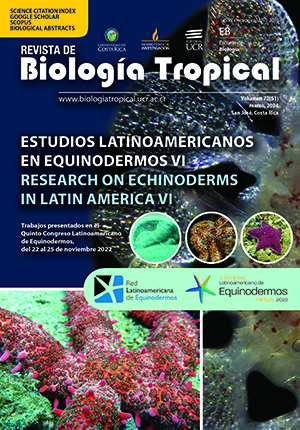Abstract
Introduction: Echinoderms are strictly aquatic animals and one of the groups of marine invertebrates whose ecological importance is crucial for the environments where they inhabit. The most outstanding characteristic is their pentaradial symmetry. These organisms can be distributed in a wide variety of oceanic environments, and are not exclusive inhabitants of reef formations. A total of 1 539 species have been registered, of which 717 belong to the Pacific and 60 of them have been registered for El Salvador.
Objective: The objective of the work was to record the richness and density of echinoderm species in rocky reefs of Punta Amapala (La Unión).
Methods: The sampling was conducted in five sites, two of them at 3 m of depth and three at 6 m. For this, snorkeling and autonomous diving were used, covering two band transects of 30 x 1 m. Within the transects, the identification (richness) and counting (abundance) of the organisms was carried out.
Results: The species that presented the highest density at 3 m reefs was Echinometra vanbrunti (0.83 indv/m2), followed by the ophiuroid Ophiocomella alexandri (0.16 indv/m2) and Ophiocoma aethiops (0.16 indv/m2). And at the 6 m reefs were Ophiothela mirabilis (0.83 indv/m2), Ophionereis annulata (0.21 indv/m2), Ophiothrix rudis (0.08 indv/m2) and Ophiocomella alexandri (0.01 indv/m2).
Conclusions: These organisms fulfill various ecological roles, such as being bioindicators of water quality by tolerating certain changes in physicochemical conditions and fulfilling the role of macrofauna hosts due to the cavities formed by some sea urchins. That is why sampling efforts must increase in these areas to monitor the quality and health of the rocky reefs, whose role is key, as they are, together with Los Cóbanos, the largest in the country.
References
Appana, S. D., & Vuki V. C. (2006). Bioerosion patterns and abundance and spatial distribution of Echinometra sp. A (green white tip) ecomorph on Nukubuco reef, Fiji. In Y. Suzuki, T. Nakamori, M. Hidaka, H. Kayanne, B. E. Casareto, K. Nadaoka, H. Yamano & M. Tsuchiya (Eds.), Proceedings of 10th International Coral Reef Symposium (pp. 938–945). Japanese Coral Reef Society.
Barraza, J. E. (1995). Equinodermos de El Salvador. En F. Serrano (Ed.), Historia Natural y Ecología de El Salvador, Tomo II (pp. 87–99). Ministerio de Educación, Gobierno de El Salvador.
Barraza, J. E., & Hasbún, C. R. (2005). Los equinodermos (Echinodermata) de El Salvador. Revista de Biología Tropical, 53(3), 139–146. https://doi.org/10.15517/rbt.v53i3.26772
Carballo, R. E., & Pocasangre, X. M. (2007). Composición y estructura de la fauna intermareal de equinodermos en el Sistema Arrecifal Rocoso Los Cóbanos, Departamento de Sonsonate, El Salvador [Tesis de Licenciatura sin publicar]. Universidad de El Salvador.
Carranza, O. A., & Rivera, A. M. (2007). Nuevo reporte de la especie Holothuria (Cystipus) rigida para El Salvador, C.A [Informe técnico]. Comité de Desarrollo Empresarial y Ambiental de Puerto Parada, El Salvador.
Contreras, R., Cruz, F., & Ibáñez, A. (1991). Observaciones ecológicas de los moluscos de la zona intermareal rocosa de la Bahía de Chamela, Jalisco, México. Anales del Instituto de Biología, Serie Zoología, 62(1), 17–31.
Thé de Araujo, J., de Oliveira, M., Mathers-Cascon, H., & Correia, A. (2018). The invasive brittle star Ophiothela mirabilis Veril, 1867 (Echinodermata, Ophiuroidea) in the southwestern Atlantic: filling gaps of distribution with comments on an octocoral host. Latin American Journal of Aquatic Research, 46(5), 1123–1127. http://dx.doi.org/10.3856/vol46-issue5-fulltext-25
Domínguez, J. P. (2011). Caracterización biofísica del área marina frente a playa Las Tunas, playas Negras, playas Blancas, playa Maculís, y Las Mueludas, Municipio de Conchagua, Departamento de La Unión, El Salvador [Reporte técnico]. Agencia de los Estados Unidos para el Desarrollo Internacional & Ministerio de Medio Ambiente y Recursos Naturales, Gobierno de El Salvador.
Hyman, L H. (1955). The Invertebrates: Echinodermata (Vol. IV). McGraw-Hill.
López-Martínez, R. E. (2017). Distribución y abundancia de la fauna intermareal de equinodermos en el Área Natural Protegida Complejo Los Cóbanos, Sonsonate, El Salvador [Tesis de Licenciatura sin publicar]. Universidad de El Salvador.
McClanahan, T. R., & Muthiga, N. A. (2007). Chapter 15: Ecology of Echinometra. En J. M. Lawrence (Ed.), Developments in aquaculture and fisheries science (Vol. 37, pp. 297-317). Elsevier.
Pawson, D. L. (2007). Phylum Echinodermata. Zootaxa, 1668, 749–764. https://doi.org/10.11646/zootaxa.1668.1.31
Ramos, F., & Segovia, J. (2021). Los equinodermos de El Salvador depositados en colecciones científicas. Revista de Biología Tropical, 69(S1), 254–264. https://doi.org/10.15517/rbt.v69iSuppl.1.46357
Segovia, J. (2012). Comunidades de Octocorales (Cnidaria: Octocorallia) en El Salvador, América Central. Tesis de Maestría, Escuela de Biología, Universidad de Costa Rica.
Segovia, J. (2023). Black coral forests and associated fauna in the mesophotic zone of Los Cóbanos, El Salvador. Revista de Biología Tropical, 71(1), e52345. Disponible en: https://doi.org/10.15517/rev. biol.trop.v71i1.52345
Segovia, J., Breedy, O., & Cortés, J. (2021). Gorgonias (Octocorallia: Alcyonacea) de aguas someras de El Salvador. Realidad y Reflexión, 54(54): 66–94. DOI https://doi.org/10.5377/ryr.v54i54.12067
Segovia, J., Guerra, G., & Ramos, F. (2017). Riqueza y distribución de equinodermos en los arrecifes rocosos de Punta Amapala y Los Cóbanos, El Salvador. Revista de Biología Tropical, 65(1), 92–100. https://doi.org/10.15517/rbt.v65i1-1.31670
Solís-Marín, F. A., & Laguarda-Figueras, A. (2010). Los equinodermos del estado de Yucatán. En R. Durán, & M. Méndez (Eds.), Biodiversidad y Desarrollo Humano en Yucatán (pp. 248–249). Dirección de Recursos Naturales, Gobierno de México.
##plugins.facebook.comentarios##

This work is licensed under a Creative Commons Attribution 4.0 International License.



